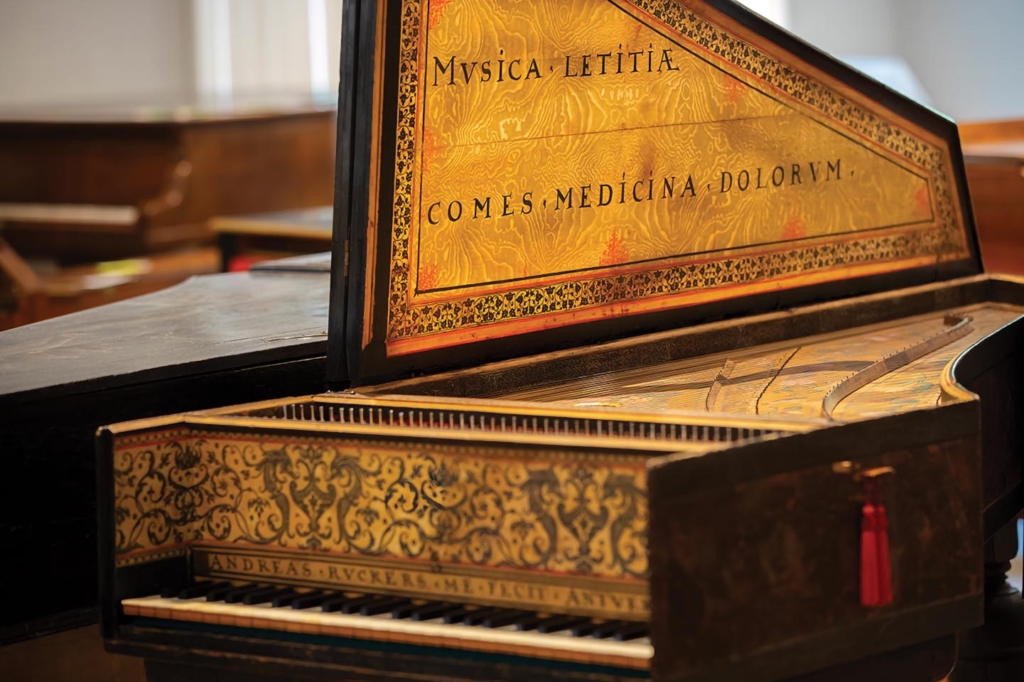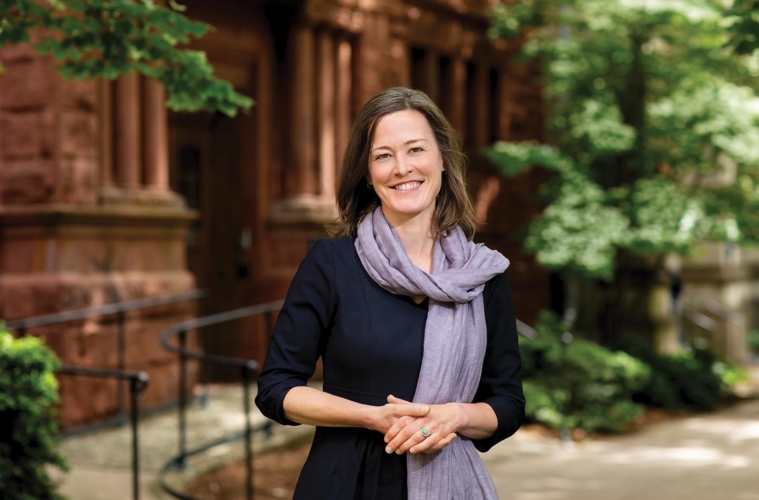For Christina Linsenmeyer ’93, music is an experience of the head, hands, and heart.
Standing in a second-floor gallery suffused with sunlight, Christina Linsenmeyer ’93 is surrounded by a menagerie of centuries-old keyboards: a slender-legged harpsichord painted with flowers and fruit, a pyramid- shaped piano topped with a black swan, an instrument with side-by-side keyboards known as a “mother and child,” and a wooden box that looks like a Bible but opens to reveal a tiny organ. Surveying the instruments, she poses a question that is central to music museums: “How do you exhibit sound?”
It’s just one of several probing questions on her mind these days. As associate curator of Yale School of Music’s Morris Steinert Collection of Musical Instruments, Linsenmeyer is envisioning the next incarnation of the gallery — currently closed for renovation — when it reopens in 2025. She wants to change how a collection presents itself, and how students, scholars, and the public interact with it. One of her goals is for visitors to ponder not only what they’re seeing, but why — in other words, to “lift the veil of objectivity” that traditionally cloaks the contents of a museum.
“Why are we seeing all these keyboards? Because Morris Steinert collected them, and Morris Steinert had certain interests and preferences,” she says. “This is a reflection of his view of the world.” (Steinert, a New Haven-based dealer for Steinway & Sons, collected keyed and stringed instruments, which he donated to Yale in 1900. The collection now numbers approximately 1,000 instruments and was recently renamed in his honor.)
In her research and teaching, Linsenmeyer has long been exploring the complex nature of value — the idea that a Stradivarius violin’s financial worth and beauty, for example, are not intrinsic but rather culturally mediated, determined by human beings subject to any number of forces, sociopolitical and otherwise. “Our beliefs, ideologies, and values change, but the objects remain static,” she says. “We make the meaning.”

Linsenmeyer’s desire to deconstruct the “hierarchy of art” comes at a time of great soul searching in museology, as discussions of decolonization, deaccessioning, and restitution take place in institutions around the world. The International Council of Museums’ International Committee for Collections of Instruments and Music, which she chairs, recently articulated three pillars with which she hopes to align her collection: diversity, equity, inclusion, and accessibility; transparency regarding provenance; and sustainability and the environment. In particular, she wants to make visible the stories behind a particular instrument and how objects help us understand and relate to the world and each other.
“Organizing by typology and classification is fine for pedagogy, but we also need to talk about people and materials,” she says. From ivory to rare wood to human bones, “we need to see the pain and bloodshed and plundering of our planet” that went into a given instrument, no matter how beautiful.
Linsenmeyer came to Colgate to study astrophysics, but credits Joscelyn Godwin, a musicologist and composer who taught at the University from 1971–2006, with her decision to pursue music. “Meeting Joscelyn changed my world,” she says. “He made music come alive.” She recalls sitting in the library listening to a Joseph Haydn symphony through headphones and thinking, “My heart just opened up.”
In addition to her experience and expertise — she is a founding curator of the Musical Instrument Museum in Phoenix and spent almost seven years in Finland as a violin maker, archivist, and researcher at the University of the Arts Helsinki, Sibelius Academy before coming to Yale in 2019 — Linsenmeyer is trying to “bring more heart” to both her curating and her musical life. A cellist and pianist since childhood, she recently started practicing kirtan, which entails call-and-response chanting and improvisation and is an important technique of bhakti yoga, focusing on devotion, attention, and awareness.
Asked if she can imagine a world without music, Linsenmeyer is unequivocal: She can’t. “Music is essential to who are we. It helps us express and process our emotions,” she says. “But it’s also vibration. All matter is vibration. We are vibration. That’s why music makes us feel we’re home.”


